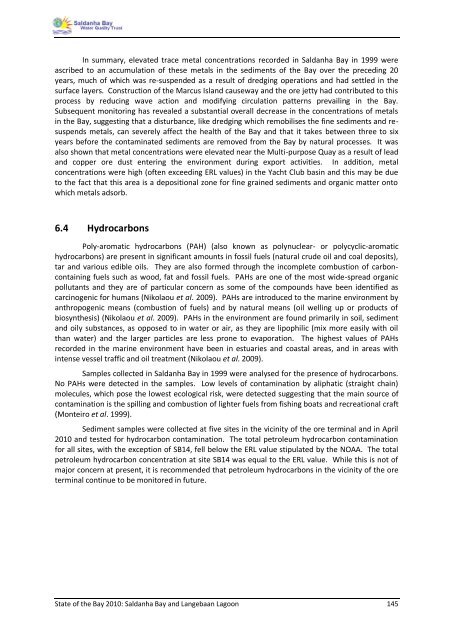State of the Bay Report 2010-Final - Anchor Environmental
State of the Bay Report 2010-Final - Anchor Environmental
State of the Bay Report 2010-Final - Anchor Environmental
Create successful ePaper yourself
Turn your PDF publications into a flip-book with our unique Google optimized e-Paper software.
In summary, elevated trace metal concentrations recorded in Saldanha <strong>Bay</strong> in 1999 were<br />
ascribed to an accumulation <strong>of</strong> <strong>the</strong>se metals in <strong>the</strong> sediments <strong>of</strong> <strong>the</strong> <strong>Bay</strong> over <strong>the</strong> preceding 20<br />
years, much <strong>of</strong> which was re-suspended as a result <strong>of</strong> dredging operations and had settled in <strong>the</strong><br />
surface layers. Construction <strong>of</strong> <strong>the</strong> Marcus Island causeway and <strong>the</strong> ore jetty had contributed to this<br />
process by reducing wave action and modifying circulation patterns prevailing in <strong>the</strong> <strong>Bay</strong>.<br />
Subsequent monitoring has revealed a substantial overall decrease in <strong>the</strong> concentrations <strong>of</strong> metals<br />
in <strong>the</strong> <strong>Bay</strong>, suggesting that a disturbance, like dredging which remobilises <strong>the</strong> fine sediments and resuspends<br />
metals, can severely affect <strong>the</strong> health <strong>of</strong> <strong>the</strong> <strong>Bay</strong> and that it takes between three to six<br />
years before <strong>the</strong> contaminated sediments are removed from <strong>the</strong> <strong>Bay</strong> by natural processes. It was<br />
also shown that metal concentrations were elevated near <strong>the</strong> Multi-purpose Quay as a result <strong>of</strong> lead<br />
and copper ore dust entering <strong>the</strong> environment during export activities. In addition, metal<br />
concentrations were high (<strong>of</strong>ten exceeding ERL values) in <strong>the</strong> Yacht Club basin and this may be due<br />
to <strong>the</strong> fact that this area is a depositional zone for fine grained sediments and organic matter onto<br />
which metals adsorb.<br />
6.4 Hydrocarbons<br />
Poly-aromatic hydrocarbons (PAH) (also known as polynuclear- or polycyclic-aromatic<br />
hydrocarbons) are present in significant amounts in fossil fuels (natural crude oil and coal deposits),<br />
tar and various edible oils. They are also formed through <strong>the</strong> incomplete combustion <strong>of</strong> carboncontaining<br />
fuels such as wood, fat and fossil fuels. PAHs are one <strong>of</strong> <strong>the</strong> most wide-spread organic<br />
pollutants and <strong>the</strong>y are <strong>of</strong> particular concern as some <strong>of</strong> <strong>the</strong> compounds have been identified as<br />
carcinogenic for humans (Nikolaou et al. 2009). PAHs are introduced to <strong>the</strong> marine environment by<br />
anthropogenic means (combustion <strong>of</strong> fuels) and by natural means (oil welling up or products <strong>of</strong><br />
biosyn<strong>the</strong>sis) (Nikolaou et al. 2009). PAHs in <strong>the</strong> environment are found primarily in soil, sediment<br />
and oily substances, as opposed to in water or air, as <strong>the</strong>y are lipophilic (mix more easily with oil<br />
than water) and <strong>the</strong> larger particles are less prone to evaporation. The highest values <strong>of</strong> PAHs<br />
recorded in <strong>the</strong> marine environment have been in estuaries and coastal areas, and in areas with<br />
intense vessel traffic and oil treatment (Nikolaou et al. 2009).<br />
Samples collected in Saldanha <strong>Bay</strong> in 1999 were analysed for <strong>the</strong> presence <strong>of</strong> hydrocarbons.<br />
No PAHs were detected in <strong>the</strong> samples. Low levels <strong>of</strong> contamination by aliphatic (straight chain)<br />
molecules, which pose <strong>the</strong> lowest ecological risk, were detected suggesting that <strong>the</strong> main source <strong>of</strong><br />
contamination is <strong>the</strong> spilling and combustion <strong>of</strong> lighter fuels from fishing boats and recreational craft<br />
(Monteiro et al. 1999).<br />
Sediment samples were collected at five sites in <strong>the</strong> vicinity <strong>of</strong> <strong>the</strong> ore terminal and in April<br />
<strong>2010</strong> and tested for hydrocarbon contamination. The total petroleum hydrocarbon contamination<br />
for all sites, with <strong>the</strong> exception <strong>of</strong> SB14, fell below <strong>the</strong> ERL value stipulated by <strong>the</strong> NOAA. The total<br />
petroleum hydrocarbon concentration at site SB14 was equal to <strong>the</strong> ERL value. While this is not <strong>of</strong><br />
major concern at present, it is recommended that petroleum hydrocarbons in <strong>the</strong> vicinity <strong>of</strong> <strong>the</strong> ore<br />
terminal continue to be monitored in future.<br />
<strong>State</strong> <strong>of</strong> <strong>the</strong> <strong>Bay</strong> <strong>2010</strong>: Saldanha <strong>Bay</strong> and Langebaan Lagoon 145

















